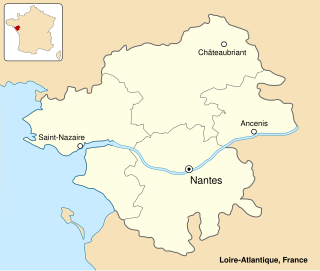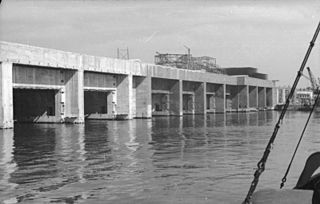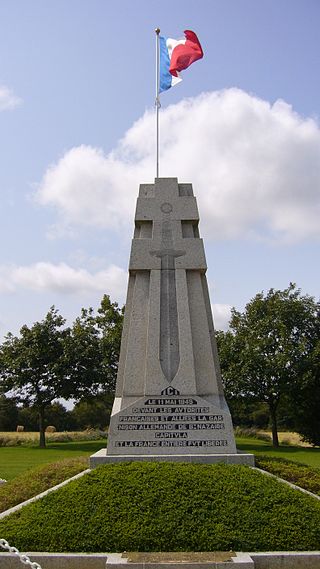
The St Nazaire Raid or Operation Chariot was a British amphibious attack on the heavily defended Normandie dry dock at St Nazaire in German-occupied France during the Second World War. The operation was undertaken by the Royal Navy (RN) and British Commandos under the auspices of Combined Operations Headquarters on 28 March 1942. St Nazaire was targeted because the loss of its dry dock would force any large German warship in need of repairs, such as Tirpitz, sister ship of Bismarck, to return to home waters by running the gauntlet of the Home Fleet of the Royal Navy and other British forces, via the English Channel or the North Sea.

An ocean liner is a type of passenger ship primarily used for transportation across seas or oceans. Ocean liners may also carry cargo or mail, and may sometimes be used for other purposes. The Queen Mary 2 is the only ocean liner still in service to this day.

Saint-Nazaire is a commune in the Loire-Atlantique department in western France, in traditional Brittany.

USS Buchanan (DD-131), named for Franklin Buchanan, was a Wickes-class destroyer in the United States Navy.

SS Europa, later SS Liberté IMO 5607332, was a German ocean liner built for the Norddeutsche Lloyd line (NDL) to work the transatlantic sea route. Launched in 1928, she and her sister ship, Bremen, were the two most advanced, high-speed steam turbine ocean vessels in their day, with both earning the Blue Riband.

HMS Campbeltown was a Town-class destroyer of the Royal Navy during the Second World War. She was originally US destroyer USS Buchanan, and was one of 50 obsolescent U.S. Navy destroyers transferred to the Royal Navy in 1940 as part of the Destroyers for Bases Agreement. Campbeltown became one of the most famous of these ships when she was used in the St Nazaire Raid in 1942.

USS Susquehanna (ID-3016) was a transport for the United States Navy during World War I. She was the second U.S. Navy ship to be named for the Susquehanna River. Before the war she operated at SS Rhein, an ocean liner for North German Lloyd. She was the lead ship of her class of three ocean liners. After the end of World War I, the ship operated briefly in passenger service as SS Susquehanna. Laid up in 1922, Susquehanna was sold to Japanese ship breakers in 1928 and scrapped.

SS Île de France was a French luxury ocean liner that plied the prestigious transatlantic route between Europe and New York from 1927 through to 1958. She was built in Saint-Nazaire for the Compagnie Générale Transatlantique, and named after the region around Paris known as "L'Ile de France". Launched in 1926, she commenced her maiden voyage on June 22, 1927, as the first major ocean liner built after World War I, and the first ever to be decorated almost entirely in modern Art Deco style. Though she was neither the largest ship nor the fastest, she was considered the most beautifully decorated built by CGT, becoming the favored ship of the pre-World War II era among the young, wealthy and fashionable elites.

Chantiers de l'Atlantique is a shipyard in Saint-Nazaire, France. It is one of the world's largest shipyards, constructing a wide range of commercial, naval, and passenger ships. It is located near Nantes, at the mouth of the Loire river and the deep waters of the Atlantic, which make the sailing of large ships in and out of the shipyards easy.

The Royal Australian Navy Heritage Centre is the maritime museum of the Royal Australian Navy. The centre opened on 4 October 2005 and is located within the Public Access Area on the northern end of the Garden Island naval base in Sydney. Since 2021, it has been temporarily closed due to redevelopment of the public-access ferry wharf.

SS Champlain was a cabin class ocean liner built in 1932 for the French Line by Chantiers et Ateliers de Saint-Nazaire, Penhoët. She was sunk by a mine off La Pallice, France, in 1940—one of the earliest passenger ship losses of the Second World War.

German submarine U-96 was a Type VIIC U-boat of the German Navy (Kriegsmarine) during World War II. It was made famous after the war in Lothar-Günther Buchheim's 1973 bestselling novel Das Boot and the 1981 Oscar-nominated film adaptation of the same name, both based on his experience on the submarine as a war correspondent in 1941.

SS La Touraine was an ocean liner that sailed for the Compagnie Générale Transatlantique from the 1890s to the 1920s. Built in France in 1891, she was primarily employed in transatlantic service on the North Atlantic. The liner was scrapped in Dunkirk in October 1923.

The Louis Joubert Lock, also known as the Normandie Dock – after the large ocean liner that provided the impetus for the facility to be built, is a lock and major dry dock located in the port of Saint-Nazaire in Loire-Atlantique, northwestern France.

The submarine base of Saint-Nazaire is one of five large fortified U-boat pens built by Germany during the Second World War in occupied Saint-Nazaire, France.

RMS Queen Mary 2 (QM2) is a British ocean liner. She has served as the flagship of the Cunard Line since January 2004, and as of 2024, is the only active, purpose-built ocean liner still in service. Queen Mary 2 sails regular transatlantic crossings between Southampton and New York City, in addition to short cruises and an annual world voyage.

Ateliers et Chantiers de la Loire (ACL) was a French shipbuilding company of the late 19th and early 20th century. The name translates roughly to English as "Workshops and Shipyard of the Loire".

Lorient Submarine Base was a submarine naval base located in Lorient, France. It was built in 1941 by the German Kriegsmarine, and was continued to be enlarged until 1943. After the German defeat it was used by the French Navy. It was decommissioned in 1995 and converted to civilian use.

The Saint-Nazaire Pocket was an Atlantic pocket that existed from August 1944 until 11 May 1945 and was formed by the withdrawal of German troops from Loire-Inférieure during the liberation of the department by the allied forces. It was centred around the port and the submarine base of Saint-Nazaire and extended to the east as far as Saint-Omer-de-Blain and from La Roche-Bernard in the north to Pornic in the south.

Fresnel was a French Navy Redoutable-class submarine of the M6 series commissioned in 1932. She participated in World War II, first on the side of the Allies from 1939 to June 1940, then in the navy of Vichy France until she was scuttled at Toulon in November 1942. She was never again seaworthy, but the Italians seized her and refloated her, and the Germans later took control of her. She was sunk in March 1944.





















